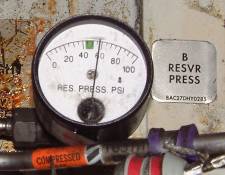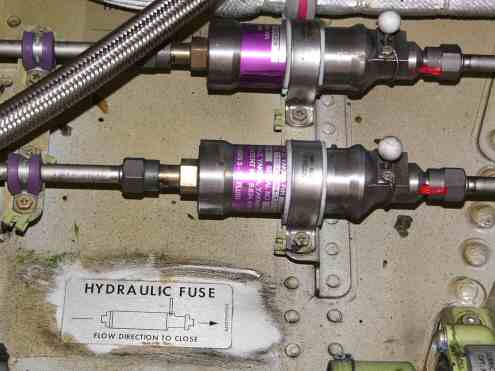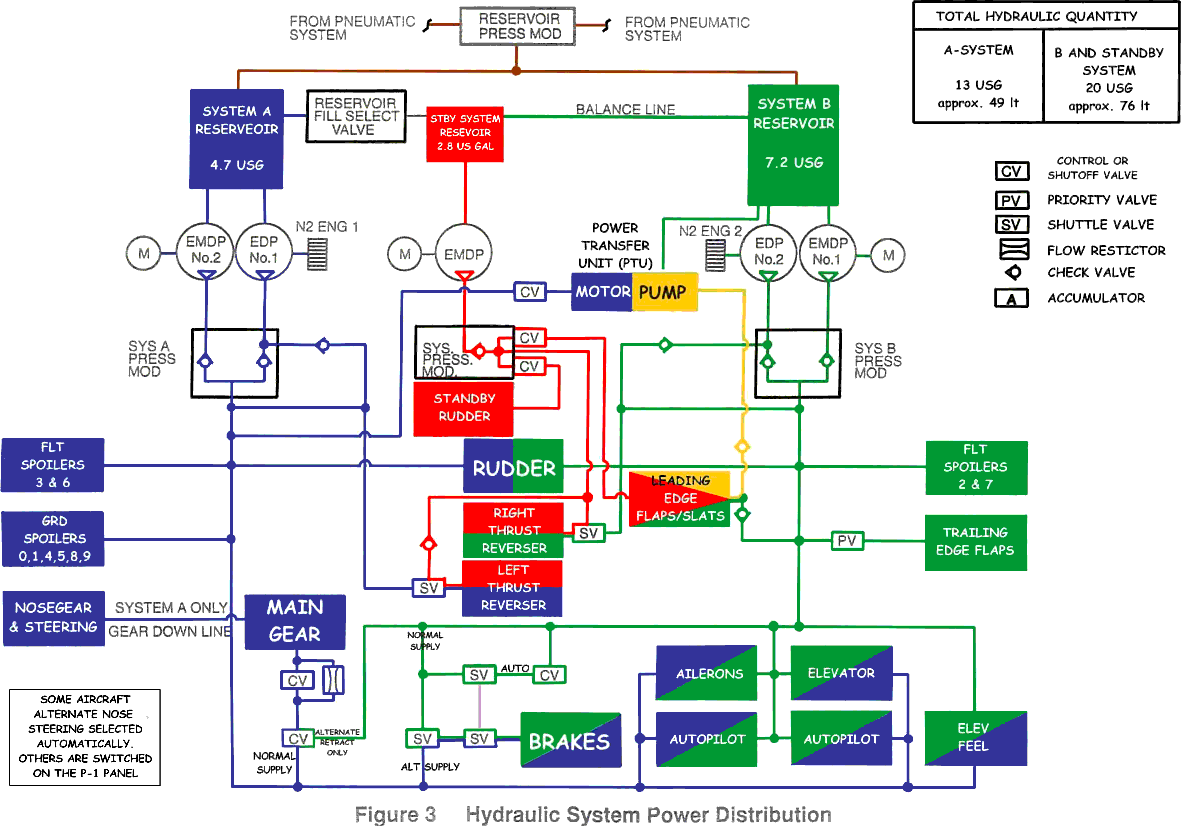Pumps

The hydraulic pump panel -1/200
The 737-1/200 had system A powered by the two Engine Driven Pumps (EDP's) and system B powered by the two Electric Motor Driven Pumps (EMDP's). There is also a ground interconnect switch to allow system A to be powered when the engines are shut down.

The hydraulic pump panel -300 onwards
From the 737-300 onwards each hydraulic system had both an EDP and an EMDP for greater redundancy in the event of an engine or generator failure.
To see the hydraulic systems (pumps, reservoirs, gauges
etc) see wheel-well fwd
Services Supplied
|
Services Supplied
|
||
| System A | System B | Standby |
| A/P "A" | A/P "B" | |
| Ailerons | Ailerons | |
| Rudder | Rudder | Rudder |
| Yaw damper | Standby yaw damper (as installed) | |
| Elev & Elev feel | Elev & Elev feel | |
| Inboard flight spoiler | Outboard flight spoiler | |
| Ground spoilers | ||
| L/E flaps & slats |
L/E flaps & slats (for extension only) |
|
| T/E flaps | ||
| PTU for autoslats | Autoslats | |
| No1 thrust reverser | No2 thrust reverser | Nos 1 & 2 thrust reversers (slow) |
| Nose wheel steering | Alt nose wheel steering | |
| Alternate brakes (man only) | Normal (auto & man) brakes | |
| Landing gear | Landing gear transfer unit (retraction only) | |
Reservoirs

Hydraulic System B Reservoir Pressure Gauge
The hydraulic reservoirs are
pressurised from the pneumatic manifold to ensure a positive flow of
fluid reaches the pumps. A from the left manifold and B from the right
(see wheel-well
fwd). The latest 737's (mid 2003 onwards) have had their hydraulic reservoir
pressurisation system extensively modified to fix two in-service problems 1)
hydraulic vapours in the flight deck caused by hydraulic fluid leaking up
the reservoir pressurisation line back to the pneumatic manifold giving
hydraulic fumes in the air-conditioning and 2)
pump low pressure during a very long flight in a cold soaked aircraft. The
latter is due to water trapped in the reservoir pressurisation system freezing
blocking reservoir bleed air supply. Aircraft which have been modified (SB
737-29-1106) are recognised by only having one reservoir pressure gauge in the
wheel well.Fuses

Hydraulic Fuses
Also in the wheel well can be seen the hydraulic fuses. These are essentially spring-loaded shuttle valves which close the hydraulic line if they detect a sudden increase in flow such as a burst downstream, thereby preserving hydraulic fluid for the rest of the services. Hydraulic fuses are fitted to the brake system, L/E flap/slat extend/retract lines, nose gear extend/retract lines and the thrust reverser pressure and return lines.


On pre-EIS aircraft (before 1988) the hydraulic gauges were similar to the 737-200. There are now separate quantity gauges since the reservoirs are not interconnected and the markings have been simplified. There is now just a single brake pressure gauge showing the normal brake pressure from system B.

737-200 Hydraulic Gauges.
Notice that there is only a system A quantity gauge, this is because on the 737-1/200 system B is filled from system A reservoir. System B quantity is monitored by the amber "B LOW QUANTITY" light above. The hydraulic brake pressure gauge has two needles because system A operates the inboard brakes and system B the outboard brakes, each has an accumulator.Quantities
This table shows the nominal quantities at different levels in the reservoirs| Aircraft Series | Originals | Classics | NG's | |
| System | Gauges | EIS | Upper CDU | |
| A | Full level | 3.6 USG | 100% | 100% (5.7Gal / 21.6Ltrs) |
| Refill | 2.35 USG | 88% | 76% | |
| EDP Standpipe | ? | 22% | 20% | |
| EMDP Standpipe | N/A | 0% | 0% | |
| B | Full level | Full | 100% | 100% (8.2Gal / 31.1Ltrs) |
| Refill | 3/4 | 88% | 76% | |
| Fill & balance line (to standby reservoir) | ? | 64% | 72% | |
| EDP Standpipe | N/A | 40% | 0% | |
| EMDP Standpipe | ? | 11% | 0% |
Note: Refill figure valid only when airplane is on ground with both engines shutdown or after landing with flaps up during taxi-in.
The hydraulic reservoirs can be filled from the ground service connection point on the forward wall of the stbd wheel well.

Hydraulic ground service connection
Normal hydraulic pressure is 3000 psiMinimum hydraulic pressure is 2800 psi
Maximum hydraulic pressure is 3500 psi
Normal brake accumulator precharge is 1000 psi
NB The alternate flap system will extend (but not retract) LE devices with standby hydraulic power. It will also extend or retract TE flaps with an electric drive motor but there is no asymmetry protection for this.
LGTU makes Hyd B pressure available for gear retraction when Engine No1 falls below 50% N2
Methods for Transfer of Hydraulic Fluid
It should go without saying that if a hydraulic system is low on quantity then you should top up that system with fresh fluid (and find out why it was low!) to avoid cross contamination. However if you really want to move fluid from one system to another here is how to do it.A to B (1% transfer per cycle)
- Chock the aircraft & ensure area around stabiliser is clear.
- Switch both EMDP's OFF.
- Release parking brakes and deplete accumulator to below 1800psi by pumping toe brakes.
- Switch Sys A EMDP ON and apply parking brakes.
- Switch Sys A EMDP OFF and depressurise through control column. (Use stabiliser rather than ailerons to prevent damage to equipment or personnel)
- Switch Sys B EMDP ON and release parking brakes. (Sends the fluid back to system B because the shuttle/priority valves send the fluid back to the normal brake system.)
- Chock the aircraft & ensure area around stabiliser is clear.
- Switch both EMDP's ON.
- Switch Sys B EMDP OFF and depressurise through control column. (Use stabiliser rather than ailerons to prevent damage to equipment or personnel)
- Switch Sys A EMDP ON and apply parking brakes. (Uses fluid from system A)
- Switch Sys B EMDP ON and release parking brakes. (Sends the fluid back to system B because the shuttle/priority valves send the fluid back to the normal brake system.)
- Ensure area around No1 thrust reverser is clear.
- Switch both EMDP's OFF
- Switch either FLT CONTROL to SBY RUD.
- Select No1 thrust reverser OUT (uses standby hyd sys)
- Switch FLT CONTROL to ON.
- Switch Hyd Sys A EMDP ON.
- Stow No 1 thrust reverser (using sys A)
--------------------------------------------------------------------------------------------------------

This is such a nice blog post. This blog post helps me to understand about all the basics of the boeing. Really helpful post. Thanks to you for sharing such kind of post.
ReplyDelete-------------------
http://www.atechhydraulics.com